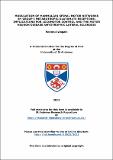Modulation of mammalian spinal motor networks by group I metabotropic glutamate receptors : implications for locomotor control and the motor neuron disease amyotrophic lateral sclerosis
Abstract
The present study examined the role of group I metabotropic glutamate receptors
(mGluRs) in mammalian spinal motor networks and investigated the potential role of
mGluRs in the fatal neurodegenerative disease amyotrophic lateral sclerosis (ALS).
Group I mGluR activation was found to modulate locomotor-related activity recorded
from ventral roots of in vitro mouse spinal cord preparations. Activation of group I
mGluRs led to an increase in the frequency of locomotor-related bursts and a decrease
in their amplitude. The cellular mechanisms underlying group I mGluR-mediated
modulation were investigated using whole-cell patch-clamp recordings from spinal
neurons. Recordings from motoneurons revealed a wide range of effects, some of
which were expected to increase motoneuron excitability, such as membrane
depolarisation and hyperpolarisation of action potential thresholds. However, the net
modulatory effect of group I mGluR activation was a reduction in motoneuron
excitability, likely reflecting a reduction in the density of fast inactivating Na+ currents. The activation of group I mGluRs also reduced excitatory synaptic input to
motoneurons, suggesting that modulation of motoneuron properties and synaptic
transmission both contribute to group I mGluR-mediated reductions in locomotor
motoneuron output. Recordings from spinal interneurons revealed a smaller range of
modulatory effects for group I mGluRs. The clearest effect on interneurons,
membrane depolarisation, may underlie group I mGluR-mediated increases in the
frequency of locomotor activity. Finally, the potential role of group I mGluRs in the
pathogenesis of ALS was investigated using a mouse model of the disease. Although
no major perturbations in group I mGluR-mediated modulation were demonstrated in ALS affected spinal cords, there appeared to be a difference in the intrinsic excitability
of spinal interneurons between wild type and ALS affected animals. Together these
data highlight group I mGluRs as important sources of neuromodulation within the
spinal cord and potential targets for the treatment of ALS.
Type
Thesis, PhD Doctor of Philosophy
Collections
Items in the St Andrews Research Repository are protected by copyright, with all rights reserved, unless otherwise indicated.

